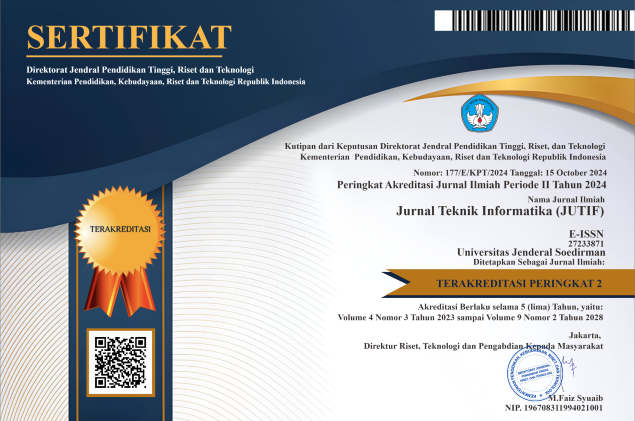Comparison of LightGBM With XGBoost Algorithms in Determining Arrhythmia Classification in Students
DOI:
https://doi.org/10.52436/1.jutif.2025.6.4.5015Keywords:
Arrhythmia, Electrocardiogram, LightGBM, Machine Learning, XGBoostAbstract
Arrhythmia is a heart rhythm disorder that may occur unpredictably with life-threatening risk if it were not treated immediately. This heart disorder generally affects the elderly, but symptoms of this disorder can also arise in children and adolescents, especially for those with heart problems or are often under stress. The implementation of this research is aimed at analyzing the symptoms of early arrhythmia in adolescent children using electrocardiogram signals. In order to obtain the best possible results in determining the higher performing algorithm, two machine learning methods were used to predict the classification of arrhythmia which will be compared for their accuracy. The subjects of this study included 106 students from SMK Swasta Teladan Sumatera Utara 2 located in the city of Medan, of which 72 final subject data were used to train the capability of both models used to predict arrhythmia classification categorized into four categories, namely normal, abnormal, potential of arrhythmia, and high potential of arrhythmia. The LightGBM model outperformed the XGBoost model, with 95.11% accuracy and 95.03% F1 Score, and although the loss value of the LightGBM model is higher than the loss value of the XGBoost model, the difference between these two values is negligible and the loss value of LightGBM can be considered as excellent with a value of 0.1503. This research contributes to the advancement of digital health by demonstrating the potential of machine learning-based ECG analysis for highly accurate early arrhythmia detection in adolescent, non-clinical populations.
Downloads
References
B. Takase et al., “JCS/JHRS 2022 Guideline on Diagnosis and Risk Assessment of Arrhythmia,” Journal of Arrhythmia, vol. 40, no. 4, pp. 655–752, Apr. 2024, doi: 10.1002/joa3.13052.
A. B. Curtis, R. Karki, A. Hattoum, and U. C. Sharma, “Arrhythmias in patients ≥ 80 years of age: pathophysiology, management, and outcomes,” J. Am. Coll. Cardiol., vol. 71, no. 17, pp. 2041–2057, May 2018, doi: 10.1016/j.jacc.2018.03.019.
S. Khurshid, J. M. Ashburner, P. T. Ellinor, D. D. McManus, S. J. Atlas, D. E. Singer, and S. A. Lubitz, “Prevalence and incidence of atrial fibrillation among older primary care patients,” JAMA Network Open, vol. 6, no. 2, p. e2255838, 2023, doi: 10.1001/jamanetworkopen.2022.55838.
A. C. Lubis, A. N. Nasution, and H. A. P. Lubis, “Prevalence of Congenital Heart Disease and Pediatric Rhythm Disorder or Arrhythmia in Children in Rantau‑Prapat City, North Sumatra, Indonesia,” J. Endocrinol. Trop. Med. Infect. Dis. (JETROMI), vol. 5, no. 4, 2024, doi: 10.32734/jetromi.v5i4.14332.
K. P. Yasa, A. A. Katritama, I. K. A. P. Harta, and I. W. Sudarma, “Prevalence and risk factors analysis of early postoperative arrhythmia after congenital heart surgery in pediatric patients,” J. Arrhythm., vol. 40, no. 2, pp. 356–362, Mar. 2024, doi: 10.1002/joa3.13011.
Y. Ansari et al., “Deep learning for ECG arrhythmia detection and classification: an overview of progress for period 2017–2023,” Frontiers in Physiology, vol. 14, p. 1246746, Sep. 2023, doi: 10.3389/fphys.2023.1246746.
P. Kligfield, L. Gettes, J. Bailey, R. Childers, B. Deal et al., “Recommendations for the Standardization and Interpretation of the Electrocardiogram. Part I: The Electrocardiogram and Its Technology,” Circulation, vol. 49, no. 10, pp. 1109–1136, 2004, doi: 10.1161/CIRCULATIONAHA.106.180200.
Z. Ebrahimi, M. Loni, M. Daneshtalab, and A. Gharehbaghi, “A review on deep learning methods for ECG arrhythmia classification,” Expert Systems with Applications: X, vol. 7, p. 100033, 2020, doi: 10.1016/j.eswax.2020.100033.
C. Xie, Z. Wang, C. Yang, J. Liu, and H. Liang, "Machine Learning for Detecting Atrial Fibrillation from ECGs: Systematic Review and Meta-Analysis," Rev Cardiovasc Med., vol. 25, no. 1, p. 8, Jan. 2024, doi: 10.31083/j.rcm2501008.
B. Mahesh, “Machine Learning Algorithms – A Review,” International Journal of Science and Research (IJSR), vol. 9, no. 1, Jan. 2019, doi: 10.21275/ART20203995.
Z. A. Ali, Z. H. Abduljabbar, H. A. Tahir, A. B. Sallow, and S. M. Al Mufti, “Exploring the power of eXtreme gradient boosting algorithm in machine learning: a review,” Academic Journal of Nawroz University, vol. 12, no. 2, pp. 320–334, May 2023, doi: 10.25007/ajnu.v12n2a1612.
M. R. Machado, S. Karray, and I. T. de Sousa, "LightGBM: an Effective Decision Tree Gradient Boosting Method to Predict Customer Loyalty in the Finance Industry," 2019 14th International Conference on Computer Science & Education (ICCSE), Toronto, ON, Canada, 2019, pp. 1111-1116, doi: 10.1109/ICCSE.2019.8845529.
D. Boldini, F. Grisoni, D. Kuhn et al., “Practical guidelines for the use of gradient boosting for molecular property prediction,” J. Cheminform., vol. 15, p. 73, 2023, doi: 10.1186/s13321-023-00743-7.
XGBoost Developers, “Parameter Tuning,” XGBoost Documentation, [Online]. Available: https://xgboost.readthedocs.io/en/stable/tutorials/param_tuning.html. [Accessed: 2-Jun-2025].
LightGBM Developers, “Features — LightGBM 4.3.0.99 documentation,” LightGBM Documentation, [Online]. Available: https://lightgbm.readthedocs.io/en/stable/Features.html. [Accessed: 2-Jun-2025].
R. Sibindi, R. W. Mwangi, and A. G. Waititu, “A boosting ensemble learning based hybrid light gradient boosting machine and extreme gradient boosting model for predicting house prices,” Engineering Reports, vol. 8, 2023, Art. no. e12599, doi: 10.1002/eng2.12599.
P. S. Rizky, R. H. Hirzi, dan U. Hidayaturrohman, “Perbandingan metode LightGBM dan XGBoost dalam menangani data dengan kelas tidak seimbang,” J. Statistika, vol. 15, no. 2, pp. 228–236, Des. 2022, doi: 10.36456/jstat.vol15.no2.a5548.
T. W. Cabral, F. B. Neto, E. R. de Lima, G. Fraidenraich, and L. G. P. Meloni, “Analysis of variance combined with optimized gradient boosting machines for enhanced load recognition in home energy management systems,” Sensors, vol. 24, no. 15, p. 4965, 2024, doi: 10.3390/s24154965.
C. T. Chung, G. Bazoukis, S. Lee et al., “Machine learning techniques for arrhythmic risk stratification: a review of the literature,” Int. J. Arrhythm., vol. 23, p. 10, 2022, doi: 10.1186/s42444-022-00062-2.
Q. Xiao, K. Lee, S. A. Mokhtar, I. Ismail, A. L. b. M. Pauzi, Q. Zhang, and P. Y. Lim, “Deep learning-based ECG arrhythmia classification: a systematic review,” Appl. Sci., vol. 13, p. 4964, 2023, doi: 10.3390/app13084964.
A. Jafari, F. Yousefirizi, and V. Seydi, “DeepBoost-AF: A novel unsupervised feature learning and gradient boosting fusion for robust atrial fibrillation detection in raw ECG signals,” arXiv, vol. 2505, no. 24085, May 2025, doi: 10.48550/arXiv.2505.24085.
H. Li, X. Hong, and B. Hu, “Analysis of arrhythmia features based on LightGBM and K-means feature extraction,” Front. Comput. Intell. Syst., vol. 5, no. 2, pp. 67–71, 2023, doi: 10.54097/fcis.v5i2.12471.
G. Silva, P. Silva, G. Moreira, V. Freitas, J. Gertrudes, and E. Luz, “A systematic review of ECG arrhythmia classification: adherence to standards, fair evaluation, and embedded feasibility,” arXiv, Mar. 2025, doi: 10.48550/arXiv.2503.07276.
T. Chen and C. Guestrin, “XGBoost: A scalable tree boosting system,” Proc. 22nd ACM SIGKDD Int. Conf. Knowl. Discov. Data Mining, pp. 785–794, 2016, doi: 10.1145/2939672.2939785.
I. D. Mienye and Y. Sun, “A survey of ensemble learning: Concepts, algorithms, applications, and prospects,” IEEE Access, vol. 10, pp. 99129–99149, 2022, doi: 10.1109/ACCESS.2022.3207287.
Additional Files
Published
How to Cite
Issue
Section
License
Copyright (c) 2025 Delima Sitanggang, Eddrick Wilbert Solo, Ferdy Immanuel Sinaga, Stefanus Jorgi L.Tobing, Feliks Daniel Hutasoit, Agung Prabowo

This work is licensed under a Creative Commons Attribution 4.0 International License.



























